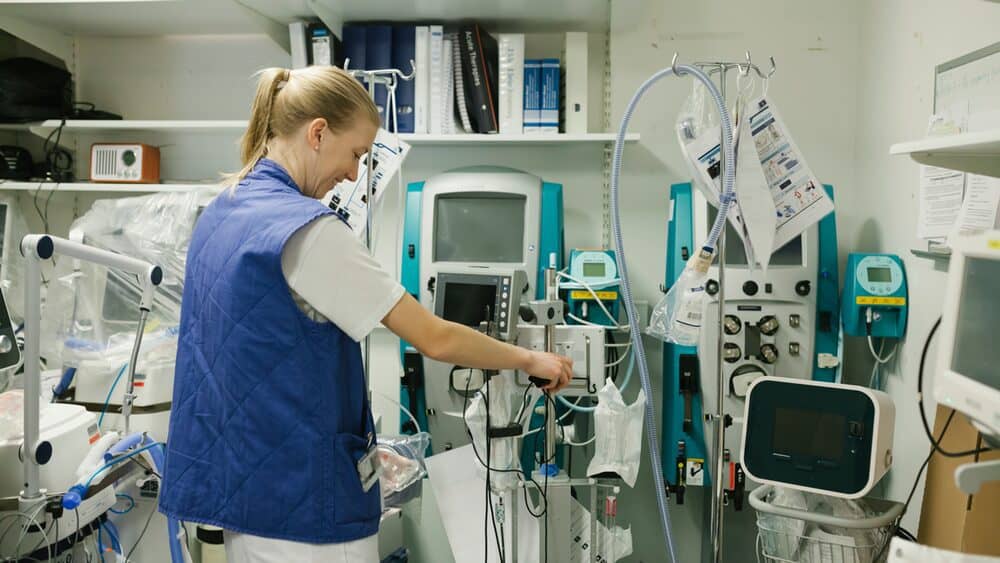When a fetal monitoring system goes down in the middle of the night, who do you call? Too often, no one knows for sure.
It’s common for healthcare facilities to have unclearly defined medical equipment service responsibilities. When these grey areas lead to service delays, the extended downtime could put patient safety at risk. Depending on the type of equipment, it may also raise compliance issues. At best, the confusion simply causes inefficiency and frustration. AAMI’s Technology Management Council (TMC) recently released a report to help HTM leaders resolve some of these grey area challenges.
Grey area equipment: medical equipment, technology, and/or furniture managed by the HTM, IT, security, facilities, or user departments.
“In the 40 years that I’ve been in the industry, medical equipment grey areas have been a topic of discussion and an area of confusion,” says Mike Busdicker, CHTM, FACHE, system director, clinical engineering at Intermountain Healthcare. “The TMC Committee saw this as an opportunity to shed light on existing practices and provide baseline guidance.”
To help healthcare facilities define the scope of inspection, testing, and maintenance responsibilities for various medical products, the TMC surveyed leadership representing nearly 200 HTM departments across North America to understand where equipment service responsibilities commonly lie. The results of the survey were compiled into a comprehensive report.
How Do Grey Areas Occur?
Healthcare facilities that don’t have service responsibility documented may experience organizational confusion that leads to inefficiency and unnecessary equipment downtime, among other issues. Advancing technology has also created grey areas as equipment become more technologically advanced.
“Service responsibility has shifted between HTM, IT, and facilities as technology has become more complex,” says Busdicker. Devices that used to be considered furniture or non-medical equipment have become clinical devices or equipment.”
Hospital beds, for example, now connect to electronic medical record (EMR) systems and contain integrated sensors and software to monitor patients’ movement, weight, and other data. In years past, few HTM departments would have serviced hospital beds. Today, about 60% of HTM departments take responsibility for this evolving example of medical equipment, according to the survey.
Patient Safety and Compliance Concerns
Regardless of the reason for the grey areas, lack of clarity around equipment service can cause confusion, frustration, and wasted time among busy clinicians. Depending on the product at issue, “passing the buck” potentially extends downtime, which leads to patient safety, regulatory compliance, incident response, and inventory control issues.
“A malfunctioning desk printer may not cause an adverse outcome, but if a patient lift isn’t working properly, and you have a patient in that room, the malfunction could result in clinicians not mobilizing or rotating that patient at the right time,” says AAMI’s Vice President of HTM Danielle McGeary, CHTM. “That’s one reason responsibility needs to be clearly defined and documented—so we’re not spending precious time figuring this out.”
Because medical equipment falls under mandates of the U.S. federal agency the Centers for Medicare & Medicaid Services (CMS), extended downtime of this equipment could affect accreditation. During an audit, on behalf CMS, the Joint Commission (TJC) review responsibility agreements and other documentation related to equipment service.
“At the end of the day we’re here for the patient,” says McGeary. “If equipment breaks on Christmas morning, facilities should have a documented plan in place that identifies who should come in and service that equipment.”
What the Results Show
The TMC compiled a list of more than 45 types of medical and non-medical equipment that tend to fall into grey areas. The committee then asked HTM leaders surveyed to select the department responsible for these products. Respondents also had the opportunity to list additional equipment excluded from the list.
Some results came as no surprise. For example, more than 80% of those surveyed reported freezers and fridges for patient food are strictly within the court of the facilities department. Other equipment, however, was more contentious. Both hospital nursery cameras and gaming systems for patient use, for instance, were notably split between HTM, facilities, IT, security, or other departments.
Health technology responsibilities can vary wildly depending on the health system and type of equipment, as exemplified by this sampling of results from a new AAMI white paper.
With help from the TJC, which accredits on behalf of CMS, the TMC also classified each type of equipment into medical equipment, utility, and other categories.
“It was helpful for TJC to provide standardized nomenclature and terminology to the report, specifically within the medical equipment and utility components chapters, which address direct links to Joint Commission standards and elements of performance,” says Herman McKenzie, director of TJC’s Department of Engineering in the Standards Interpretation Group. “The document will help HTM professionals become better aware of how healthcare equipment fixtures and devices are managed by healthcare organizations.”
How HTM Leaders Can Use the Guidance Document
The TMC committee developed the report as a resource for the HTM industry and not as a recommendation of service responsibilities. It serves as a guide to help HTM, facilities, and other healthcare leaders standardize their own processes. It may also help resource-strapped HTM departments take the lead in redefining responsibilities if they choose.
“The report may help them justify what they should and shouldn’t be servicing,” says McGeary. “The survey results give them data to back their claim.”
Documenting Roles and Responsibilities
The report makes clear that written documentation of equipment service responsibility is essential to ensure patient safety and compliance. Regardless of how healthcare facilities allocate responsibility, “it is imperative to have written policy defining departmental roles and responsibilities for these devices and systems,” the report states.
The TMC committee recommends that leaders of all applicable departments jointly develop and agree upon this document. A written policy delineating service responsibilities serves as a responsibility agreement for accreditation purposes. Success of the agreement is measured by the extent service delivery teams and other affected departments are aware of, and buy into, the agreement, the report states.
Evolving Responsibilities
The TMC committee recommends healthcare facilities review and update their equipment service responsibility document periodically. To help inform those updates, the TMC committee intends to conduct more grey area surveys in the future.
“We intend to resurvey the field to see how things change over time,” says McGeary. “Depending on the response, it may trigger another project. We’d also like to hear success stories on how HTM leaders have used this information to structure equipment responsibilities. We’ve had a lot of interest from the field so far and anticipate this report will be welcomed by the field.”
Members of AAMI can download Gray Areas of Equipment Service in HTM from AAMI ARRAY.





Hi can you send me a link or the results of the TMC survey. I’d like to take a look at it.
I will search for this survey but if someone knows where I can find it…
For 28 years I have never taken care of hospital beds. The separation of clinical and non-clinical equipment is important but I have seen a recent trend of anything involved with a patient is biomeds responsibility. I am not totally against this as long as if I have non clinical equipment issues, I can turf it to facilities, or work in collaboration with them. In a perfect world, I would love to work with IT, facilities, and others in mutual collaboration to maintain all aspects of systems and equipment in the medical facility.
The other day I received a work order for changing batteries to a alcohol station. I informed them that I think it is the responsibility of facilities or housekeeping but if they don’t get any action call me and I will do it.
Communication with the C-suite on industry standards is important!